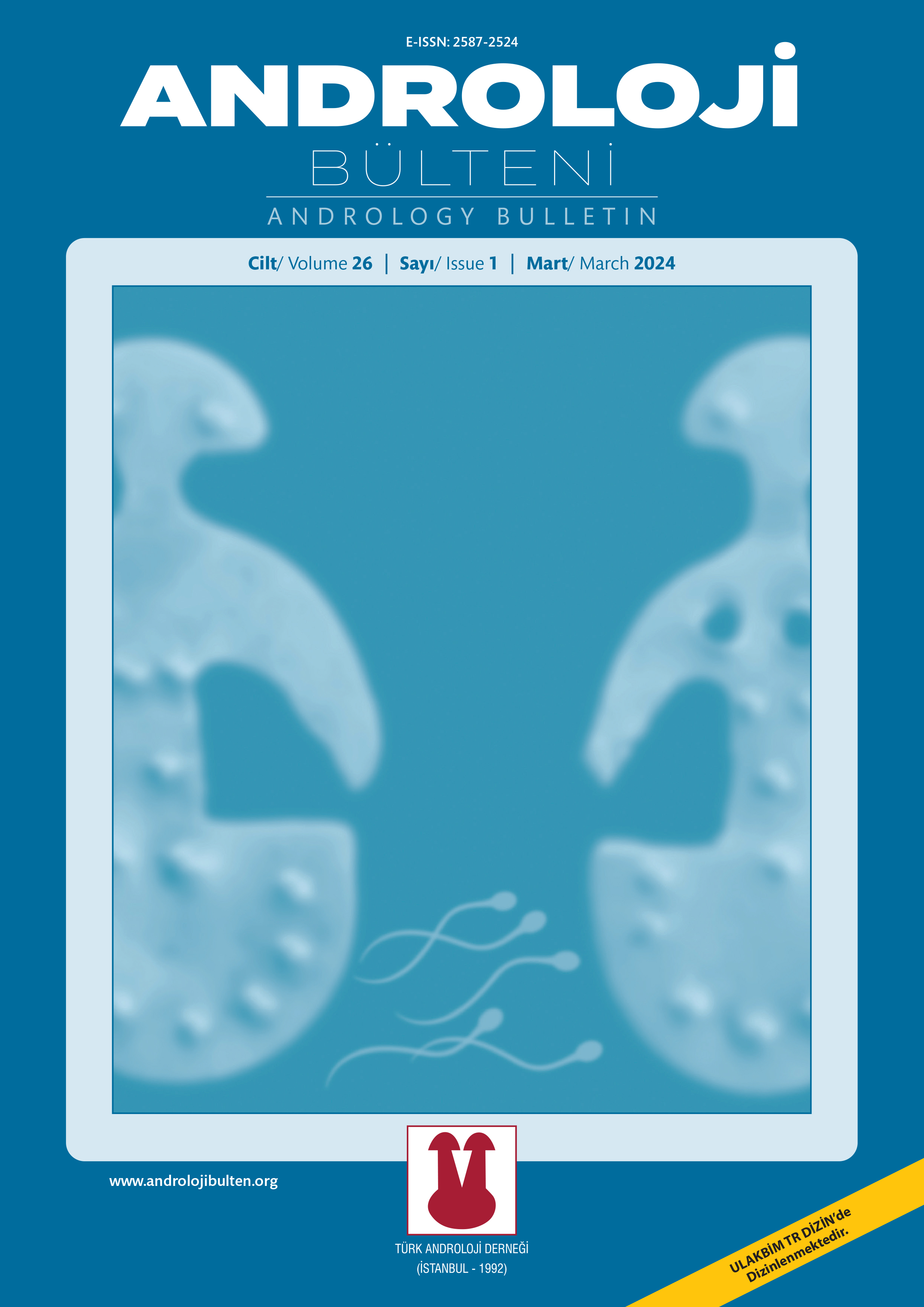
Bu derginin içeriği Creative Commons Atıf-GayriTicari 4.0 Uluslararası Lisansı kapsamında lisanslanmıştır.
İdiopatik hipogonadotropik hipogonadizm nedenli erkek infertilitesinde gonadotropin tedavisinin değerlendirilmesi
Muhammed Arif İbiş1, Kaan Aydos21Sağlık Bilimleri Üniversitesi, Keçiören Eğitim Araştırma Hastanesi, Üroloji Anabilim Dalı, Ankara, Türkiye2Ankara Üniversitesi Tıp Fakültesi, Üroloji Anabilim Dalı, Ankara, Türkiye
AMAÇ: İdiopatik hipogonadotropik hipogonadizm (IHH) tanısı konulan infertil erkeklerde human koryonik gonadotropin (hCG)/human menopozal gonadotropin (hMG) tedavisinin etkinliğini ve klinik sonuçlarını değerlendirmek.
GEREÇ ve YÖNTEMLER: Ocak 2017 – Aralık 2018 tarihleri arasında IHH tanısı konulan 60 hastanın tedavi öncesi ve sonrası verileri retrospektif olarak incelendi. Hastalar gebelik elde edilen ve edilemeyenler olarak iki gruba ayrılarak yaş, vücut kitle indeksi (VKI), testis hacimleri, tedavi sonrası saptanan maksimum serum total testosteron, folikül stimüle edici hormon (FSH) ve lüteinleştirici hormon (LH) değeri ile tedavide uygulanan ortalama hCG ve hMG dozları ve sperm konsantrasyonları karşılaştırıldı.
BULGULAR: Tedavi sonrası 3. ve 6. ayda hormonal parametreler ve testis volümünde anlamlı düzelme saptandı (p<0,001). Genel olarak hastaların %83,3’ünde sperm elde edildi. %66,7’sinde doğal yolla, %10’unda invitro fertilizasyon (IVF) ile olmak üzere olguların %76,7’sinde klinik gebelik elde edildi. ÜYT ile gebelik elde edilen olgularda ortalama sperm konsantrasyonu 3,4±1,04 milyon/ml iken normal yollarla gebelik elde edilenlerde 12,2±0,68 milyon/ml idi. Gebelik elde edilen ve elde edilemeyen iki grup arasında sperm konsantrasyonları açısından fark saptandı (11,1 milyon/ml vs 0,2 milyon/ml, p<0,001). Ek olarak bu gruplar arasında testis volümü ve serum FSH değerleri bakımından anlamlı farklılık saptandı (sırasıyla p<0,001 ve p=0,029).
SONUÇ: IHH, medikal tedavi ile yüksek başarı oranları sağlanabilen nadir erkek infertilite nedenlerinden biridir. Tedavi sonrası ölçülen testis hacimleri ve FSH değerleri tedavinin başarısını öngörmede etkili parametrelerdir.
Anahtar Kelimeler: Gonadotropin tedavisi, hCG, hipogonadotropik hipogonadizm, hMG
Evaluation of gonadotropin therapy in male infertility caused by idiopathic hypogonadotropic hypogonadism
Muhammed Arif İbiş1, Kaan Aydos21Department of Urology, University of Health Sciences, Kecioren Training and Research Hospital, Ankara, Turkey2Department of Urology, Ankara University School of Medicine, Ankara, Turkey
OBJECTIVE: To evaluate the efficacy and clinical results of human chorionic gonadotropin (hCG)/human menopausal gonadotropin (hMG) treatment in infertile men diagnosed with idiopathic hypogonadotropic hypogonadism (IHH).
MATRERIAL and METHODS: The pre and post treatment data of 60 patients diagnosed with IHH between January 2017 and December 2018 were retrospectively analyzed. The patients were divided into two groups as those with or without pregnancy. Age, body mass index (BMI), testicular volumes, maximum serum total testosterone, follicle stimulating hormone (FSH) and luteinizing hormone (LH) values measured after treatment, and mean hCG and hMG doses and sperm concentrations were compared.
RESULTS: After the treatment, there was a significant improvement in hormonal parameters and testicular volume (p<0.001). Spermatozoa were found in 83.3% of the patients. Clinical pregnancy was achieved in 76.7% of the cases, 66.7% by spontaneous pregnancy and 10% by in vitro fertilization (IVF). While the mean sperm concentration was 3.4±1.04 million/ml in cases with pregnancy achieved by ART, it was 12.2±0.68 million/ml in those who were pregnant by spontaneous. A significant difference was found between the cases with and without pregnancy in terms of sperm concentration, testicular volume and serum FSH values (p<0.001, p<0.001 and p=0.029, respectively).
CONCLUSION: IHH is one of the rare causes of male infertility that can achieve high success rates with medical treatment. Testicular volumes and FSH values measured after treatment are effective parameters in predicting the success of the treatment.
Keywords: Gonadotropin therapy, hCG, hypogonadotropic hypogonadism, hMG
Makale Dili: Türkçe
(1042 kere indirildi)













